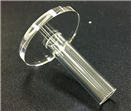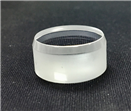

Time:2024-04-08
Sapphire lenses are a high-strength material known for their extraordinary hardness, durability, and scratch resistance. They have excellent optical properties, including high transmittance and low light dispersion, making them suitable for use in lenses and other optical components. But its cost is relatively high, and there are many factors that contribute to the high cost, including:
1. Material cost
Sapphire is a crystalline form of aluminum oxide (Al2O3), and the process is complex and time-consuming, requiring high temperatures, controlled environments, and specialized equipment. Compared to other types of glass, sapphire has a relatively high raw material cost, resulting in a higher price.
2. High melting point
Sapphire has a high melting point of approximately 2040 ° C (3704 ° F), requiring specialized furnaces and energy intensive processes to melt and shape, making the manufacturing process more challenging and expensive.

3. Difficult to cut and shape
The cutting, shaping, and polishing of sapphire are difficult and time-consuming, requiring specialized tools and expertise. The high cost of cutting and shaping sapphire lenses increases their overall cost.
4. Low output
The production of sapphire involves a large amount of waste, as the material is difficult to cut and shape, resulting in low output. This means that a large amount of sapphire material will be wasted during the manufacturing process, further increasing costs.
5. Professional application
Sapphire lenses are typically used for special applications that require their unique properties, such as high strength, scratch resistance, and optical transparency.
The high cost of sapphire lenses can be attributed to various factors, such as raw material costs, challenging manufacturing processes, low production volumes, limited availability, and the demand for professional applications, all of which contribute to the high price of sapphire.






Tel
Mobile phone
Customer service
TOP